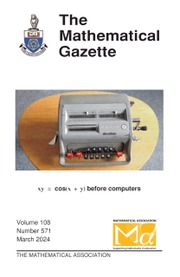Crossref Citations
This article has been cited by the following publications. This list is generated based on data provided by
Crossref.
French, Doug
1995.
Computer algebra systems and A level examinations Some thoughts prompted by Martin Taylor's article.
The Mathematical Gazette,
Vol. 79,
Issue. 486,
p.
545.
Ruthven, Kenneth
1996.
The technology test: new items for a new era.
The Mathematical Gazette,
Vol. 80,
Issue. 488,
p.
360.
Houston, Ken
1996.
Assessing A level mathematics.
The Mathematical Gazette,
Vol. 80,
Issue. 489,
p.
538.
David, Bowers
1997.
Opportunities for the use of computer algebra systems in middle secondary mathematics in England and Wales.
Zentralblatt für Didaktik der Mathematik,
Vol. 29,
Issue. 4,
p.
113.
French, Doug
1998.
School algebra and the challenge of the TI 92.
The Mathematical Gazette,
Vol. 82,
Issue. 493,
p.
62.
Henn, Harald
1999.
Customer-Value-Implementierung.
p.
1.
Monaghan, John
2000.
Some issues surrounding the use of algebraic calculators in traditional examinations.
International Journal of Mathematical Education in Science and Technology,
Vol. 31,
Issue. 3,
p.
381.
Pountney, David
Leinbach, Carl
and
Etchells, Terence
2002.
The issue of appropriate assessment in the presence of a CAS.
International Journal of Mathematical Education in Science and Technology,
Vol. 33,
Issue. 1,
p.
15.
Graham, T
Headlam, C
Honey, S
Sharp, J
and
Smith, A
2003.
The use of graphics calculators by students in an examination: what do they really do?.
International Journal of Mathematical Education in Science and Technology,
Vol. 34,
Issue. 3,
p.
319.
Berry, John
and
Graham, Ted
2005.
On high-school students' use of graphic calculators in mathematics.
Zentralblatt für Didaktik der Mathematik,
Vol. 37,
Issue. 3,
p.
140.
Graham, E.
Headlam, C.
Sharp, J.
and
Watson, B.
2008.
An investigation into whether student use of graphics calculators matches their teacher's expectations.
International Journal of Mathematical Education in Science and Technology,
Vol. 39,
Issue. 2,
p.
179.
Dickison, Philip
and
Kenny, Lorraine E.
2012.
Adding Normal Laboratory Values to Nurse Competence Examinations: Effects on Item Difficulty.
Journal of Nursing Regulation,
Vol. 3,
Issue. 1,
p.
40.
Abdelaal, Fatma
2025.
Open-book assessment in French language instruction: a study on enhancing the grammatical skills of pre-service teachers.
Language Testing in Asia,
Vol. 15,
Issue. 1,

